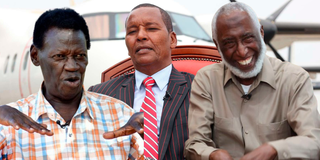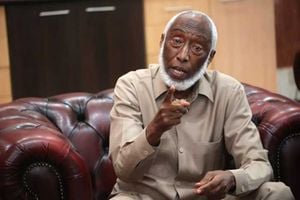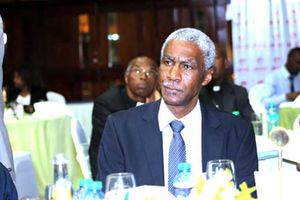
Major (Rtd) Charles Munyeki Wachira, Major (Rtd) Hussein Mohammed and Col (Rtd) Hussein Farah.
Charles Munyeki Wachira’s first train ride from Kisumu to Nakuru cost him Sh10. Wachira had enrolled at Eregi Teacher Training College for two years between 1973-74, graduating as a P1 tutor. At the time, trainee teachers had a Sh20 monthly government stipend.
Barely in his twenties, the young man who had missed by a point selection to join Alliance for A-levels had resolved that setback would not put them down. After a short stint at a school in Mbale, he had been promoted to deputy headmaster and transferred to another in Narok. Here he would clash with the headmaster who had taken away iron sheets meant to repair dilapidated roofing in some classrooms.
He was hauled before the local education official on accusations of engineering a strike by teachers. “I could not stomach children being subjected to the harsh learning environment, some even forced to learn under trees because facilities were inadequate. And the little material available to improve their welfare is taken away,” Wachira recalls of an incident he says forced him to quit teaching.
He sought to try his luck in the upcoming army recruitment that had been advertised. But the limited slots at the Kenya Armed Forces Training College in Lanet had attracted a huge crowd- he estimates there were about 4, 000 prospective job seekers.
But most fell through the cracks in the various screening stages- minimum education qualifications, medical tests, rigorous exercises, both on and off the field. “At one point, a fellow candidate asked that I help him with a sample of my urine. I flatly rejected the request that I found odd,” he recalls. Wachira was among the successful recruits who joined as a cadet in 1976, a development that set him on the path to following in the footsteps of his father who had been detained at Manyani during the colonial era and had fought in the second world war. Wachira was commissioned as a second lieutenant in 1977 following the only pass-out parade ever held in Mombasa because at the time President Jomo Kenyatta was there on medical grounds.
Eastleigh Airbase
Five years earlier, Hussein Ahmed Farah, who had grown up in Nanyuki during the Mau Mau uprising, had also been called up to Eastleigh Airbase for air force selection after much prodding to apply to join the military. In 1971, after his A-Levels, Farah secured a job at the National Bank of Kenya. Four months into the bank job, his supervisor had literary forced him to apply for the military post, including dictating to him the application.
“I jokingly asked him four years after Shifta war, who would enlist a shifta into the air force,” Farah, the chairman of Blue Bird aviation, recalls in an interview at Wilson Airport. He was invited for a five-day interview. From hundreds of applicants, only 10 finally made the cut. He quit his banking job in September 1971, joined military training and in March 1973 trained as a Cadet. He would rise to a squadron commander, train as a flying instructor in the UK and by 1979, he was training students of the newly created army’s 50th Air Calvary Battalion (50 ACB). Farah, 74, retired as a colonel.
A similar lucky streak saw Unshur Mohammed allowed to join military training at Lanet in 1977, passing out as a cadet in March 1978- the last group (intake 8) to be commissioned by President Kenyatta. Initially, Unshur had been turned away for being underweight but the then commandant of the college found him stranded.
On learning the reason for disqualification, and given his academic papers were in order, he waived the requirement since there was no recruit enrolled from northern Kenya. Unshur went on to train as an army attack helicopter pilot, served as squadron commander and retiring as a Major after 12 years. For over 30 years, he has been in civil aviation where he is the chief executive of Blue Bird aviation. Wachira and Unshur were peers at 50th Air Calvary Battalion (50 ACB). After retiring from the military, the trio found themselves working from the same base: Wilson Airport.
Wachira was posted to 7 KR Lang’ata barracks as an infantry officer for a year. Colonel Daudi Tonje (he later rose to Chief of General Staff) who was the chief instructor at Lanet tapped him as an instructor, promoted him to Lieutenant and thereafter Captain. In 1980, Captain Wachira was posted to 50th Air Calvary Battalion (50 ACB) as a flight cadet. He trained as a helicopter pilot at Embakasi Garrison and went on to attend numerous trainings in the US hosted by the US Army and helicopter manufacturers. The rushed establishment of the 50 ACB had thrown up some odd scenarios.
“I was a captain but I found myself in flying school with some of my juniors I had trained in Lanet and who had been commissioned as second lieutenants,” Wachira recalls with a chuckle during an interview with Nation.Africa. Even more hilarious was before pass out as cadets, Wachira’s cohorts in the air force had been promoted prematurely in preparation for training as fighter pilots in the United States. The US couldn’t admit them before commissioning as cadets. Therefore, the Kenyan government had promoted the selected air force trainees to second lieutenants before pass-out! This meant when their peers visited them at their camps, they were their seniors. “We suddenly found ourselves having to salute our peers from the air force,” Wachira recounts the ironic twist at the time. The crash programme to set up the army aviation unit was partly sponsored by the United States, which was working to counter Russian influence in the region during the Cold War era. In 1982, he was among 50 ACB army pilots who flew helicopter gunships that helped quell the coup attempt. President Moi awarded him a head of state’s commendation (military division) on September 5, 1983, for his role in quelling the coup.
Chief pilot
Wachira served in various capacities including promotion to a major squadron commander in 1984 until his retirement in 1988 after 12 years of service. The pilot who had trained at the helicopter manufacturer, Eurocopter, in US, later joined Kenya Pipeline as the chief pilot. He has worked as a civilian pilot for over 30 years in a career that has seen him fly numerous Kenyan and foreign VIPs. His VIP passengers have included retired presidents Uhuru Kenyatta, Daniel Moi, Jakaya Kikwete (as minister) and the late Benjamim Mkapa (Tanzania). Others are Dr William Ruto as Deputy President, former Prime Minister Raila Odinga, the late Tanzania President John Magufuli (as minister), and the late Kenyan minister Nicholas Biwott. He also worked for the National Airways Corporation in South Africa as an emergency rescue helicopter pilot in 2004 and Helibip Company of South Africa which seconded him to Tanzania in 2006. There he worked in the goldmines until February 2008.
As an air accident investigator, Wachira was part of a team that investigated the helicopter crashes that killed Internal Security Minister George Saitoti in 2012 and Eastern Provincial Commissioner Ishmael Chelang’a in 1996. By 2012, he had flown helicopters for about 30 years with over 9, 000 cumulative flight hours. The ex-military officer has flown various choppers including AS 350, Bell 206, Hughes 500 and Bell 212. His last Kenya Civil Aviation Authority-issued private pilot license was issued on January 24, 2020. He ventured into farming in retirement.







